I headed down to breakfast. On weekends it paid to get down early before all the other tourists clambered in; there were not many tables for the size of hotel. I watched the commotion; overgrown pears dashing up for the next batch of sticky buns as they arrived.
As I sat down with my cereal and yoghurt, I overheard the tail end of a conversation between two men sitting on adjacent tables. Apparently there had been a news clip on one of the many flat screens adorning the walls of the breakfast room, the subject being discussed was the U.S. stance on North Korea's missile tests.
"I think we should drop a big bomb on them, move in, and turn right!" blurted one of the chaps. The other chap gave a gobbledygook answer that I couldn't decipher. Move right to where I thought, South Korea? Do these guys ever stop to think of the consequences of "moving in", do they anticipate the effects of the power vacuum left behind? Were no lessons learned from the Iraq war? Sometimes I despair, especially considering the inspiring leader they have.
After topping up my funds at an ATM, my money was evaporating quickly here, and being charged for the privilege, I headed across to the MET. The MET on Fifth Avenue presents over 5,000 years of art spanning all cultures and time periods. Since the Museum opened its doors to the public in its current location in Central Park in 1880, its footprint has expanded to cover more than two million square feet.
This great art museum was already crowded when I arrived. One needs a sticker on your front before you can gain access to any of the galleries, so join the long line to the ticket desk. On arriving at the head of the queue, the girl smiled sweetly and quickly rattled off, "Welcome to the MET, sir. Are you a member? Ah, you're not. Well you require a sticker to enter the museum. We give people the option of paying the suggested entry fee, or pay whatever you can." I observed the price for a senior was $17, fairly standard for most museums, so I chickened out and paid the suggested $17. I overheard the Americans behind me preparing to offer 20% less.
I soon identified a couple of free one hour long guided tours that I thought would prove interesting. Having an hour to kill before my first tour, I walked through the Roman antiquities galleries. A small voice attracted my attention, and I was tickled to hear a small boy about the same age as my grandson, say to his mam, "Ooh, that's cool," as he pointed to a Roman bass relief frieze.
 "The Birth of Venus" : Alexandre Cabanel - 1875 |
She led us first to a gallery to show us a picture of "The Birth of Venus" : Alexandre Cabanel - 1875. Patiently, she pointed out the smooth, perfectly rendered bodies and flesh tones, very carefully composed, with no hint of a brush stroke. At the time when the painting was created, all art was rigorously controlled by the Salons. They were the market place where artists exhibited, and in order for them to progress their careers, it was vital that they made it in the Salons. The Salon would sit in judgement, and artists were expected to follow formulated procedures to their craft. Almost smooth canvases were expected with no hint of a brush stroke, as if the paint had been licked on. The content was also rigorously controlled. Nudity was allowed so long as it was gods, goddesses or mythical. Our guide was cleverly presenting the background to how and why Impressionism arose.
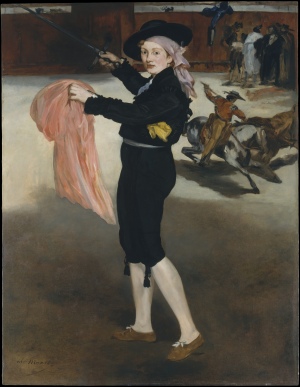 "Mademoiselle Victorine in the Costume of an Espada" Manet - 1862 |
In 1874, a group of artists called the Anonymous Society of Painters, Sculptors, Printmakers, etc. organised an exhibition in Paris that launched the movement called Impressionism. Its founding members included Claude Monet, Edgar Degas, and Camille Pissarro, among others. The group was unified only by its independence from the official annual Salon, for which a jury of artists from the Académie des Beaux-Arts selected artworks and awarded medals. The independent artists, despite their diverse approaches to painting, appeared to contemporaries as a group. While conservative critics panned their work for its unfinished, sketch like appearance, more progressive writers praised it for its depiction of modern life.
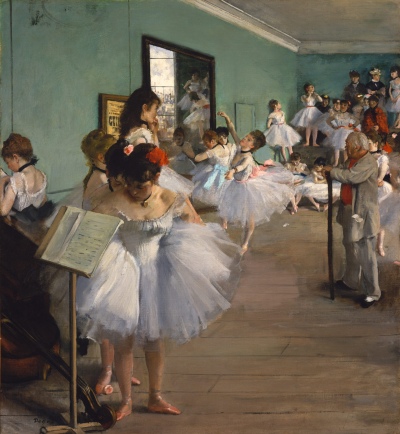 "The Dance Class" : Edgar Degas - 1874 |
Meanwhile a member of our group, a lady roughly my height and clearly a know-all, always managed to be standing in front of me so that I could not get a clear view of the artistic works. When she wasn't blocking my view, she was always within earshot, going through a ritualistic, "Hmm.. hmm.. " routine to every word the guide uttered, or emitted a school girl giggle at something which did not register as funny to any of the rest of us. Enough of my whinging!
Our guide took us through a string of paintings. "The Dance Class" : Edgar Degas - 1874, resembled a photo in some ways, catching the young dancers in their natural poses, rather than the contrived poses expected by the Salons. Ballet dances were often the lowest of the low, just one step up from prostitution.
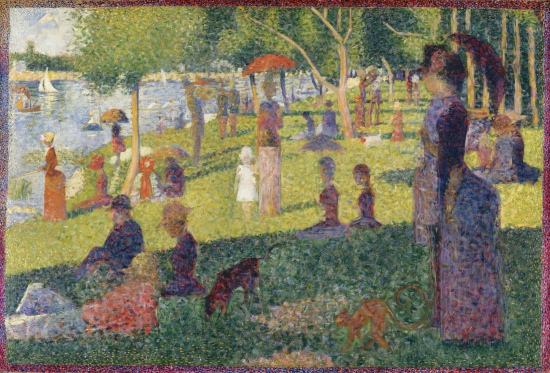 "A Sunday on La Grande Jatte" : Georges Seurat - 1884 |
Monet's characteristically loose painting style complements the leisure activities he portrays. Landscapes, which figure prominently in Impressionist art, were also brought up to date with innovative compositions, light effects, and use of colour. Monet in particular emphasized the modernization of the landscape by including railways and factories, signs of encroaching industrialization that would have seemed inappropriate to the Barbizon artists of the previous generation.
Its many facets and varied participants make the Impressionist movement difficult to define. Indeed, its life seems as fleeting as the light effects it sought to capture. Even so, Impressionism was a movement of enduring consequence, as its embrace of modernity made it the springboard for later avant-garde art in Europe.
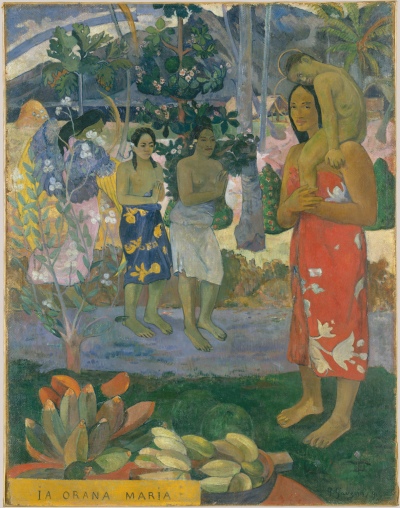 "Ia Orana Maria (Hail Mary)" : Paul Gaugin - 1891 |
In the 1880s, Georges Seurat was at the forefront of the challenges to Impressionism with his unique analyses based on then-current notions of optical and colour theories. Seurat believed that by placing tiny dabs of pure colours adjacent to one another, a viewer's eye compensated for the visual disparity between the two by "mixing" the primaries to model a composite hue. The Study for "A Sunday on La Grande Jatte" 1884 embodies Seurat's experimental style, which was dubbed Neo-Impressionism. This painting, the last sketch for the final picture that debuted in 1886 at the eighth and final Impressionist exhibition (today in the Art Institute of Chicago), depicts a landscape scene peopled with figures at leisure, a familiar subject of the Impressionists. But Seurat's updated style invigorates the otherwise conventional subject with a virtuoso application of colour and pigment.
The art of Paul Gauguin developed out of similar Impressionist foundations, but he too dispensed with Impressionistic handling of pigment and imagery in exchange for an approach characterized by solid patches of colour and clearly defined forms, which he used to depict exotic themes and images of private and religious symbolism. Gauguin's peripatetic disposition took him to Brittany, Provence, Martinique, and Panama, finally settling him in remote Polynesia, at first Tahiti then the Marquesas Islands. Hoping to escape the aggravations of the industrialized European world and constantly searching for an untouched land of simplicity and beauty, Gauguin looked toward remote destinations where he could live easily and paint the purity of the country and its inhabitants. In Tahiti, he made some of the most insightful and expressive pictures of his career. "Ia Orana Maria (Hail Mary)" - 1891 resonates with striking imagery and Polynesian iconography, used unconventionally with several well-known Christian themes, including the Adoration of the Magi and the Annunciation. He described this picture in a letter to a dealer friend in Paris: "An angel with yellow wings points out Mary and Jesus, both Tahitians, to two Tahitian women, nudes wrapped in pareus, a sort of cotton cloth printed with flowers that can be draped as one likes from the waist" (letter to Daniel de Monfreid, March 11, 1892).
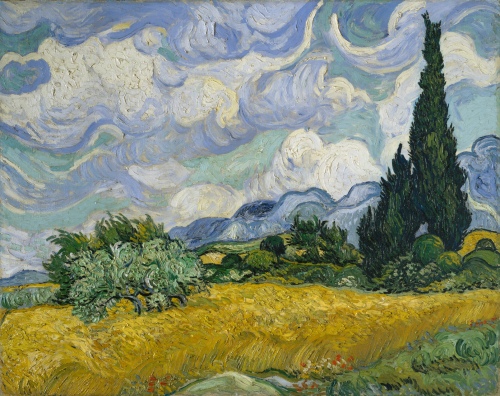 "Wheat Field with Cypresses" : Vincent van Gogh - 1889 |
Our guide had cleverly exposed how all the artists had revolted the Salons and had developed their own individual styles. Some rooms displayed many examples of one particular artist's work enabling us to see how their work had evolved over time. In other instances, the work of two different artists, whose subject matter was very similar but their approaches were totally different, were shown side by side. This was deliberately arranged to provoke discussion about the styles.
The lady had cleverly taken us on an historic tour through Impressionism and Post-Impressionism. It is always refreshing to get another person's view on something that you think you are familiar with, and I came away with a whole new insight.
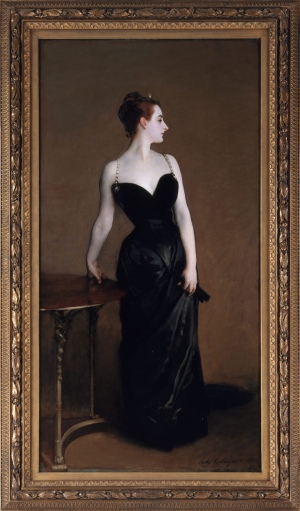 "Madame X (Madame Pierre Gautreau)" John Singer Sargent - 1883-84 |
A brisk walk brought us to an elegant portrait of "Madame X (Madame Pierre Gautreau)" : John Singer Sargent - 1883-84. The Louisiana-born Virginie Amélie Avegno (1859-1915) was known in Paris for her artful appearance. Sargent hoped to enhance his reputation by painting and exhibiting her portrait. Working without a commission but with his sitter's complicity, he emphasized her daring personal style, showing the right strap of her gown slipping from her shoulder. At the Salon of 1884, the portrait received more ridicule than praise. Sargent repainted the shoulder strap and kept the work for over thirty years. When, eventually, he sold it to the MET, he commented, "I suppose it is the best thing I have done," but asked that the Museum disguise the sitter's name.
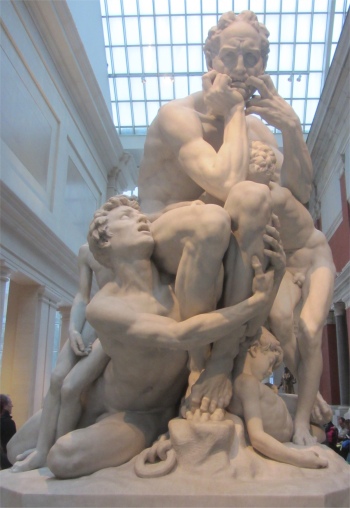 "Ugolino and His Sons" : Jean-Baptiste Carpeaux - 1865-67 |
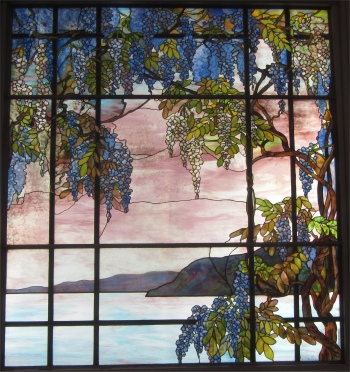 "View of Oyster Bay" : Tiffany Studios - 1908 |
One of America's most acclaimed artists, Louis Comfort Tiffany's career spanned from the 1870s through the 1920s. He embraced virtually every artistic and decorative medium, designing and directing his studios to produce leaded-glass windows, mosaics, lighting, glass, pottery, metalwork, enamels, jewellery, and interiors. As the son of Charles Lewis Tiffany (1812-1902), founder of Tiffany & Company, the fancy goods store that became the renowned jewellery and silver firm, Tiffany chose to pursue his own artistic interests in lieu of joining the family business.
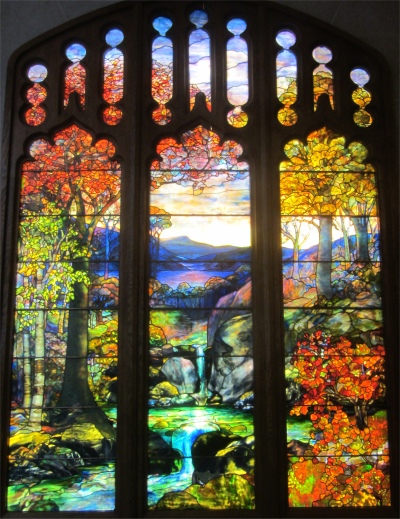 "Autumn Landscape" : Tiffany Studios - 1923-24 |
Of all of Tiffany's artistic endeavours, leaded-glass brought him the greatest recognition. Tiffany and his early rival, John La Farge, revolutionized the look of stained glass, which had remained essentially unchanged since medieval times when craftsmen utilized flat panes of white and coloured glass with details painted with glass paints before firing and leading. Tiffany and La Farge experimented with new types of glass and achieved a more varied palette with richer hues and greater density. By 1881, each had patented an opalescent glass, a unique American phenomenon that featured a milky, opaque, and sometimes rainbow-hued appearance with the introduction of light. Internally coloured with variegated shades of the same or different hues, Tiffany's Favrile glass enabled craftsmen to substitute random tonal gradations, lines, textures, and densities inherent in the material itself for pictorial details. "Magnolias and Irises" (1981.159 ), executed by Tiffany Studios around 1908, was designed as a memorial window based on a well-known motif-the "River of Life". It depicts magnolias composed of opalescent drapery glass, heavily folded or creased glass, and iris in multihued tones illustrating Tiffany's ability to "paint" with glass.
Tiffany's artisans fabricated an illusionistic window, "View of Oyster Bay" : Tiffany Studios - 1908, framed by a trellis and wisteria vines dripping with blue and white blossoms. The view is remarkably similar to that of Long Island from Tiffany's country estate, Laurelton Hall, in Oyster Bay. The window was commissioned, however, by William C. Skinner for his New York City town house as a reminder of the family estate in Holyoke, Massachusetts, named Wistariahurst for the abundant vines surrounding the home.
Nearby blazed another window, "Autumn Landscape" : Tiffany Studios - 1923-24. A tour de force of its medium, this window, executed late in Tiffany's career, portrays the late afternoon sun filtered through rich autumnal foliage. It was probably designed by Agnes Northrop, who was known especially for her landscapes and flowers. No paint was used to add detail; rather, the modelling, texture, and form were created solely with glass, using the full range developed at Tiffany Studios. The variegated surface was made by wrinkling glass in its molten state. Different colour effects were achieved by embedding tiny, confetti-like flakes of glass in the surface. Plating, the superimposition of several layers of glass on the back of the window, added depth. Although commissioned in 1923 by Loren D. Towle for the stair landing of his enormous neo-Gothic mansion in Boston, the window was never installed. In 1925, Robert W. de Forest, Tiffany's close friend, donated the window to the Museum, where he was president and founder of the American Wing.
 Museums within Museums |
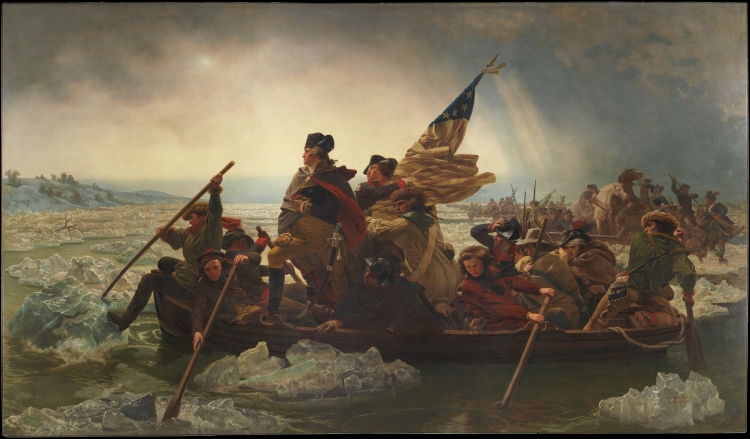 "Washington Crossing the Delaware" : Emanuel Leutze - 1851 |
Both tours had given me valuable insights into the museum and the art within, and I would recommend anyone visiting the MET to take advantage of them. Left to my own devices, I spent a while wandering around the American Art galleries which served as a good guide as to how the country had evolved. Then I did my best to tackle the European Art from 1250 up to the present.
By this time it was after 6pm. I had been on my feet here for over seven hours, and I was starting to feel it; a sign of my age. Although I felt as though I had only scratched the surface of the MET, I decided to call it a day. I left the museum and stepped out into a light, cold rain which was following in from a previous snowfall. With the wind chill it still felt exceedingly cold, but hopefully it might shift some of the snow from the pavements.
I headed back to my abode passing groups of excellent buskers in the subways, delighted that I had finally got to the MET, and that I did do it some justice.
 Buskers on Subways |
